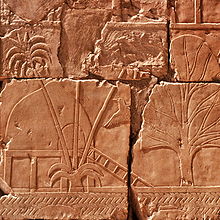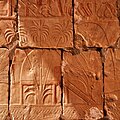Punt (goldland)
| Punt in hieroglyphics | |||||
|---|---|---|---|---|---|
| New kingdom |
Punt Pwnt |
||||
| Detail of a hut in Punt in the mortuary temple of Hatshepsut | |||||
Punt was a gold country , the name of which is documented by ancient Egyptian inscriptions. Another name for the region was "Ta Netjer" (" God's land ") as a tribute to the goddess Hathor . There are only guesses as to which today's place was meant.
The Egyptians imported from Punt probably since the 3rd millennium BC. Chr. Incense , ebony , ivory , gold, eyeshadow , silver, salt, monkeys, dogs, panther skins and ostrich feathers and eggs. Representations and Egyptian inscriptions show that Punt was east of Egypt by the sea and that the inhabitants, who can be divided into three groups according to clothing and hairstyle, lived in stilt houses and raised cattle. According to ancient Egyptian mythology , the god land of Utenet is also said to be in Punt .
Expeditions to Punt
A particularly short overland connection from the Nile to the Red Sea ended at Koptos (Gebtu), which has therefore long been an important trading center for the Egyptians. A caravan could cover the distance in five days. Many expeditions to Punt also started here. The oldest known expedition to Punt was carried out by King ( Pharaoh ) Sahure ( 5th Dynasty ). Also in the 5th dynasty, the official Bawerdjed led an expedition to Punt during the reign of Djedkare . Under the reign of Mentuhotep III. an officer named Henenu traveled to Punt.
The most famous expedition was undertaken by Queen Hatshepsut, led by Nehesis, to acquire myrrh and cedar trees, among other things . A report of this trip has been preserved as a relief in the mortuary temple of Hatshepsut on the wall of a pillar hall ("Punch Hall") in Deir el-Bahari .
- Reliefs in the mortuary temple of Hatshepsut
Hatshepsut's successor Thutmose III. is said to have conquered Punt in the first year of his reign. Later pharaohs also organized partly military, partly economic expeditions to Punt.
Ramses III. also mentions an expedition to Punt: “I had large menhou (transport ships) built, followed by BAIR with large teams and protection troops. They left the great sea of Muqed and reached the mountains of Punt, land of incense, safely and without major losses, for I instill great fear in all. "
In 2006, researchers from the Universities of Boston and Naples found remains of ropes and planks that were used for loading boats in five caves near Mersa Gawasis on the Red Sea, south of the Egyptian city of Safaga .
In addition, the remains of a box with the inscription “Wunder des Landes Punt” were discovered; next to it the damaged name of Amenemhet III. , which the antiquities administration in Cairo evaluates as further evidence that the Egyptians also had sea trade with punt at the time of the pharaohs.
Localization of punt
In Egyptology , the exact location of Punt has long been puzzled. Some researchers have associated punt with Ophir , a biblical fabulously rich country or gold country. In the demotic papyrus " The Homecoming of the Goddess " it is described that a walk to Punt takes 120 days and the goddess Tefnut covered this distance in three days.
It is undisputed that Punt must lie northeast to southeast of Egypt. Until the discovery of the temple of Hatshepsut in Deir el-Bahari, it was generally assumed that Punt was in Asia, mostly somewhere in Arabia. After the discovery of the temple, an inscription was found there which says that the gods had "set the southern borders (of Egypt) as far as Punt". This was seen as a strong indication of a situation in Africa, which was supported by the depiction of various animals that are generally associated with Africa. In addition, a hymn from the time of the New Kingdom tells how Min descends over the mountains of Medja on his way back from Punt, from where he brings fragrant incense , i.e. comes from the south along the Nile.
After David Lorton and John J. Bimson worked out an analysis that indicated a location southeast of Nubia , this view largely prevailed. Accordingly, one suspected Punt in the Horn of Africa , perhaps in today's Somalia (where the de facto autonomous region of Puntland refers to it in its name today ) or in Eritrea . It was considered less likely that it could be located much further south, for example in Mozambique or Zimbabwe , since the distance to Egypt was too great and even in Roman times the geographical knowledge in Tanzania had ceased. Some even identified Punt with the trading center Opone (Οπώνη) mentioned in Claudius Ptolemy , Geographike Hyphegesis IV, 7 and in the Periplus Maris Erythraei , the modern Hafun south of the Horn of Africa. In Eritrea, the old port of Adulis south of Massaua and Qohaito in the west of the country, where ebony, gold and incense were traded in ancient times , are considered possible punt.
Most recently, the Egyptologist Stefan Baumann emphasized that, from an Egyptian perspective, the Punt region was on the edge of the known world and was therefore difficult to reach and grasp. Furthermore, a limit that is valid for all times cannot be established. It can be assumed that with the expansion of the trade network under Ptolemaic and Roman domination, the geographical understanding of Punt also changed. By this time at the latest, the frankincense regions in Arabia also belonged to what the Egyptians defined as punt.
literature
- Kathryn A. Bard, Rodolfo Fattovich (eds.): Harbor of the Pharaohs to the Land of Punt. Archaeological investigations at Mersa / Wadi Gawasis, Egypt, 2001-2005. Università degli Studi di Napoli "L'Orientale", Napoli 2007, ISBN 978-88-95044-11-8 .
- Francis Breyer: Punt. The search for the "land of God". Brill, Leiden / Boston 2016, ISBN 978-90-04-32260-8 .
- Johannes Duemichen : The fleet of an Egyptian queen from the XVII. Century BC and ancient Egyptian military depicted in festive dress on a monument from the same time. In addition to an appendix containing the fish of the Red Sea attached as an ornament below the fleet in the original size of the monument, a chronological number of images of ancient Egyptian ships, and some depictions and inscriptions from various temples and tombs that relate to the above. As a contribution to the history of shipping and trade in antiquity. Hinrichs, Leipzig 1868, digitized .
- Rodolfo Fattovich: The Problem of Punt in the Light of the Recent Field Work in the Eastern Sudan. In: Sylvia Schoske (Hrsg.): Files of the fourth international Egyptologist congress. Munich 1985. Volume 4: History - administrative and economic history, legal history - neighboring cultures (= studies on ancient Egyptian culture. Vol. 4). Buske, Hamburg 1991, ISBN 3-87118-904-9 , pp. 257-272.
- Rolf Herzog : Punt (= treatises of the German Archaeological Institute in Cairo, Egyptian series. No. 6, ISSN 0418-971X ). Augustin, Glückstadt 1968.
- Dimitri Meeks: Locating Punt. In: David O'Connor, Stephen Quirke (eds.): Mysterious Lands (= Encounters with ancient Egypt. No. 5). Institute of Archeology, University College London and University College London Press, London et al. 2003, ISBN 1-84472-004-7 , pp. 53-80.
- W. Max Müller : Asia and Europe according to ancient Egyptian monuments. Engelmann, Leipzig 1893.
- Adolphe J. Reinach: Reports on the Fouilles de Koptos. (Janvier - février 1910). Addresses à la Société Française des Fouilles Archéologiques et extraits de son Bulletin, augmentés de huit planches et d'un plan. Leroux, Paris 1910 (reprint. (= A VSB egyptological report. ) VanSiclen Books, San Antonio 1988, ISBN 0-933175-21-3 ).
- Rodolfo Fattovich: Punt. In: Kathryn A. Bard (Ed.): Encyclopedia of the Archeology of Ancient Egypt. Routledge, London 1999, ISBN 0-415-18589-0 , pp. 636-37.
Web links
- Hatshepsut expedition
- Text and translation of Hatshepsut's expedition report
- The wonderful land of Punt (English)
Individual evidence
- ↑ James Henry Breasted : A History of Egypt. From the earliest Times to the Persian Conquest. 2nd edition, fully revised. Charles Scribner, New York NY 1951, p. 280.
- ↑ A list of the conquests of Thutmose III. is located in the Temple of Amon in Karnak .
- ^ Report of the 2005/2006 excavation season ( Memento of October 8, 2008 in the Internet Archive ).
- ↑ Source: dpa January 2006; Bard, Fattovich (Ed.): Harbor of the Pharaohs to the Land of Punt. 2007.
- ↑ The sunrise takes place in June with an azimuth of 65 degrees and in January / February with an azimuth of 105 degrees (0 degrees = north, 90 degrees = east, 180 degrees = south)
- ↑ ( Page no longer available , search in web archives: ZDF Expedition: Lag Punt in today's Eritrea? )
- ↑ Stefan Baumann: Treasury. Your decoration and room concept in Egyptian temples of the Greco-Roman times . Studies on the late Egyptian religion 19. Harrassowitz, Wiesbaden 2018, ISBN 978-3-447-10975-8 , p. 325-327 .





